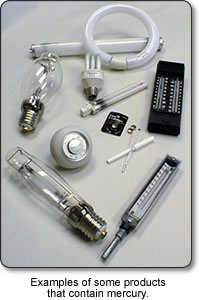Mercury in Laboratories
The use of elemental mercury should be eliminated whenever possible. EHS will take elemental mercury thermometers, switches and devices free of charge.
- All spills must be cleaned up immediately with a mercury spill kit. Contaminated debris and spill absorbants must be disposed of promptly through EHS.
- Contact EHS (646-1762) if you have a spill that has is beyond your ability to control or represents an exposure risk.
- Elemental mercury has relatively low acute toxicity but does present a potentially significant long-term exposure risk.
- Mercury can produce colorless, odorless, and difficult to detect vapor at room temperature. Mercury spills are very difficult and expensive to clean up.
- If spilled, elemental mercury in cracks of lab benches or floor tiles may pose an exposure hazard for years.
- Replace mercury thermometers with non-mercury alternatives (available through the Scientific Stockroom or from EHS) or electronic devices to measure temperature and pressure.
Here are some alternatives to standard mercury thermometers and mercury containing devices:
- Spirit filled thermometers meeting NIST/ANSI/SAMA standards for accuracy (-100 to +250°C)
- Dial thermometers (-50 to +540°C)
- Digital thermometers (-70 to +1000°C)
- Shatterproof or fluoropolymer coated mercury filled thermometers (-20 to +750°C)
- Digital and analog vacuum gauges

Several items that may contain mercury:
Thermometers
Switches
Thermostats
Appliances
Vehicles
Lights [Fluorescent, HID lamps(High Intensity Discharge), Mercury Vapor, High Pressure Sodium, Metal Halide, Neon]
Batteries
Paints
Medical products
Instruments
If you must use mercury in your research - Use these precautions to prevent mercury spills and contamination:
- Never move or store equipment with mercury thermometers in place, as they break easily.
- Containers of mercury must be clearly labeled and sealed at all times. Containers should only be opened within the fume hoods. Shatterproof containers are best and they must be stored within a secondary containment bin. Bins are available at no charge from EHS.
- Mercury should never be allowed to enter drains or evaporate. Collect all spilled mercury promptly. Protect cup sinks and drains from contamination. Used or unwanted mercury must be disposed of as a hazardous waste through EHS.
- Portable devices containing mercury (manometers, McLeod gauges) must be sealed with an airtight and leak proof seal (valve or septum etc.) when not in use. They must also be stored in secondary containment bins.
- Vacuum pumps must be protected from contamination by mercury and mercury vapor through the use of inline activated carbon filters and/or suitable cold traps. Contact EHS if you have questions.
- Items that have come in contact with mercury or mercury vapor can become contaminated and must be disposed of as hazardous waste or cleaned. Contact EHS with questions on effective decontamination of non-porous items like glass, ceramic, or metal.
ORGANIC MERCURY (ALKYL AND ARYL) COMPOUNDS
Organic mercury compounds pose special hazards in the laboratory. Under all circumstances, these compounds must be handled according to the "Working with Particularly Hazardous Substances" in the College's Chemical Hygiene Plan. Alkyl mercury compounds require prior approval from EHS before purchase or use. Contact EHS for assistance in planning, use and disposal before using these compounds.




